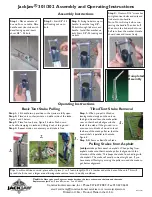
14
8. Maintenance
8.1
Safety Measures
Danger
Maintenance, repair and subsequent conversion work
may be carried out only by specially trained personnel
in accordance with the operating instructions and/or
special conversion instructions. Training and
information sessions for personnel can be provided by
the competent Siemens department.
Before starting any work on vacuum circuit-breakers,
reference must be made to the local safety regulations
for high-voltage switchgear. Switch off the power
supply and then close and open the vacuum circuit-
breaker manually (breaker in open state, “closing
spring discharged” indication is visible) to ensure that
the closing spring is discharged.
Control terminals must not be touched if the power
supply is connected.
Non-observance can result in death, severe
personal injury or substantial damage to
property.
The 3AF 01 vacuum circuit-breakers in general require
little maintenance. The interval at which the
maintenance is to be carried out depends on the
application by the client. The parameters to be
considered are :
—
The number of short circuit operations the CB is
subjected to,
—
the switching frequency,
—
the service duty, and
—
Ambient conditions temperature, humidity,
pollution level at the site.
8.2
Maintenance schedule
The maintenance schedule is given as a guideline.
However depending upon particular operating & site
conditions, the schedule should be fixed up.
—
As per the site conditions once a year
(a) Visual inspection*
(b) Cleaning of insulators** and operating
mechanism parts (plungers, moving joints,
etc...) as per clause 7.7
(c) Check functioning of space heater.
(d) Check vacuum as per clause 7.6.
(e) Dielectric tests as per clause 7.7.
—
Every 10 years or after 10,000 operations check for
contact erosion as per clause 7.5.
—
Check supply (A.C.) and battery (D.C.) voltages
regularly to ensure proper ratings to operate
breaker electrically.
* It is recommended nonetheless a regular visual inspection for
soiling (e.g. dust, saline fog, fungus etc.) of the circuit-breaker.
** The periodicity of insulator washing is to be determined by the
site personnel based on the amount of pollutions deposited.
8.3
Typical Maintenances Sequences
1.
Put the circuit-breaker off.
2.
Isolate the circuit-breaker.
3.
Earth the circuit-breaker.
4.
Disconnect the auxiliary supply.
5.
Discharge the springs manually.
6.
Visually inspect the circuit-breaker and carry out
further maintenance.
8.4
Lubrication of the parts
To achieve higher level of reliability, we recommend
lubrication after 4,000 operations. However lubrication
will be required more frequently depending upon dusty
atmospheric conditions at site.
The points to be lubricated are marked in Figs. 7 and 13.
These figures also show the type of lubrication of various
points. In short the same are as follows :-
Fig. 13 Points on the vacuum breaker to be
lubricated
Bearings, sliding surfaces:
Isoflex Topas L 32
Bearings inaccessible to grease and bearings of
the auxiliary switch S1:
Shell Tellus 32 (Oil)
To lubricate the mechanism remove the cover. Lubricate
the appropriate points beginning at the top left and
working downwards. Parts that are not rigidly fixed (e.g.
joints) should be moved slightly to and fro to let the
lubricant penetrate. Following this, operate the breaker a
few times to test it.
Joints and bearings that cannot be dismantled should be
cleaned with a cleaning agent prior to begin oiled.
Key to parts
a Lever for snap switch
operation
b Bearing for lever
c Cam disc
d Lever for switch-on block
e Lever for operating the
auxiliary switch
f Auxiliary switch
g Guide for opening spring
h Operating rod of auxiliary
switch
j Bearing for switching shaft
k Lever for switch-off block
I Lever on the switching
shaft
m Damping plate
p Pin for opening spring
a
b
c
d
g
f
e
h
j
k
l
m
p
j
Содержание 3AF 01
Страница 1: ...s 3AF 01 Outdoor Vacuum Switchgear 36 kV Operating Instructions Manual 4P 0080 03 95273 001AB ...
Страница 22: ...20 Notes ...
Страница 23: ...21 Notes ...









































